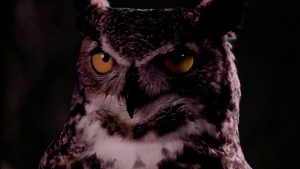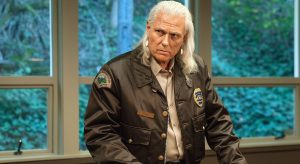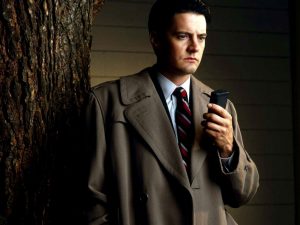“Diane, I’ve a feeling we’re not in Kansas anymore.” Today, dear listener, we go both current and retro with a guest review and opinion piece by writer/journalist Paul StJohn Mackintosh, no stranger to these pages, on the entire three series of that iconic television show, Twin Peaks.
Having not watched Twin Peaks ourselves since it originally came out (when we were fairly obsessional over Special Agent Dale Cooper), we were keen to see what Paul made of it all, and as usual, he brings his critical razor with him. As well as interpretations which you may or may not share. So pour yourself a cup of damn fine coffee, put your feet up on that log, and prepare for the fray…
WARNING – THIS ARTICLE DOES CONTAIN SPOILERS, PARTICULARLY IF YOU HAVEN’T SEEN SERIES THREE
Usual disclaimer: All views expressed by guest writers are their own, not those of the site or owners; photos are copyright their originators, and shared here under fair use for review purposes only.
Locked Down in the Black Lodge: Twin Peaks 30 years on
by Paul StJohn Mackintosh
The calamitous year 2020 marks, among other things, the 30th anniversary of the release of Twin Peaks. As it happens, I spent my coronavirus lockdown in Budapest catching up on the series on HBO. I hadn’t even realised that the 2017 Season 3 sequel/continuation had been released. I hadn’t rewatched the original series since it came out in 1990-91, which gives some idea of my own credentials as a David Lynch fanboy. All the same, after binge-watching all three seasons, I had a few reflections on the series that I thought I’d share.
For one thing, the original Twin Peaks has worn remarkably well with time. It’s amazing how in retrospect the original puzzles, frustrations and longueurs that seemed to gall so badly back in the day now feel relatively straightforward and untaxing. Perhaps televisual narrative technique has just finally caught up with David Lynch, but the original Twin Peaks now feels to me effectively paced and well-judged in bringing off its reveals. Mike the one-armed man reveals the true nature of Bob in more or less completely explicit detail in Season 2 Episode 6, laying to rest the mystery of who killed Laura Palmer aside from the small detail of finding his earthly vessel. Similarly, Windom Earle’s data dumps bring us up to speed pretty fast on the nature of the Black Lodge, and why he’s seeking it (like any James Bond villain, it’s to rule the wuuurld…) Hindsight is always 20:20, but still, Twin Peaks Season 1 and 2 seem far more satisfying and fulfilling on second viewing.
There is much to seriously like in the new Season 3 as well. Many not-so-lesser characters get a healthy slice of the narrative, and in some cases their story arcs and character development are brought to a satisfying resolution. Deputy Hawk gets a fitting share of screen time, although unfortunately often in service to Magical Indian-type cliches about his heritage. Gordon Cole and Albert Rosenfield play a solid double-act alongside new FBI Special Agent Tammy Preston, providing some really meaty investigative scenes. Deputy Andy and his new fellow Deputy Bobby Briggs also mature well as characters with the passage of time, as does Ben Horne, now apparently the man of integrity he set out to become at the end of Season 2. Margaret Lanterman the Log Lady, in Catherine Coulson’s last screen appearance before her sad death from cancer, delivers depth and pathos without even getting up from a chair.
Not everyone comes off so well. Doctor Jacoby and Nadine Hurley have a kind of platonic romance, while Ed Hurley and Norma Jennings finally achieve happiness together after 25 years, but their stories feel hardly worth the screen time devoted to them. The same applies to many of the new characters wheeled on for Season 3, who often come across as rushed ciphers compared to their deeply realized forebears a generation back. One good thing to say about them is that at least the season’s plot doesn’t dwell on them too much.
Laura Palmer herself is back, and apparently resurrected, or at least rediscovered in an alternative timeline, in the last episode of Season 3. There are many hints along the way that “Laura is the One,” still a figure of great metaphysical significance in the cosmology of the Twin Peaks universe, yet her true role, and why she’s back, are still left unclear at the end of the season. However strong a presence she is when she is onscreen, it’s hard to feel much of an emotional charge at her return.
Other aspects of Season 3 are better at delivering the air of spiritual profundity and enigmatic depth that Lynch could often conjure in the first two seasons. The black-and-white scenes in the strange palace above the purple ocean in Season 3 Episode 8 are some of the lushest, richest essays Lynch has ever managed in that personal idiom, and they also tell the origin story of both Bob and Laura Palmer in wordless but completely effective mime. In those scenes, Lynch hasn’t needed to make one single concession towards more explicit, articulated narrative, yet he’s managed to get the point across beautifully and completely. Those scenes work so well that you wish there could have been more like them, not less. For sure, the initial atomic explosion in the episode runs on a tad long, especially compared to the much shorter bursts of fire in the 1990-91 series, like some tribute to the StarGate scenes in Kubrick’s 2001 without space pods.
We also get even more, and better, clarification of the various symbols and tropes aired in the first two seasons. All those electric wires and conduits? Well, electricity, it turns out, is the metaphor for a form of spiritual energy, same as the good or black fire of “fire walk with me.” And the Good Giant of the Black Lodge (or Waiting Room) is the Fireman – a figure who controls, starts, stokes, or puts out fires. And so on. The proliferation of doubles is explained by that old Tibetan trope of tulpas or thought-forms, manufactured people imitating their originals. Even the pyramidal Twin Peaks symbol is revealed as a disassembled figure-of-eight infinity symbol.
THE COOPER CONUNDRUM
With Laura Palmer out of the picture for most of the season, and Twin Peaks timesharing with other settings, it’s time to address another centre of gravity for the original seasons that feels a whole lot more lightweight now that it’s been moved to the axis of the entire narrative. If the new Twin Peaks is the Fantabulous Emancipation of One Dale Cooper, then this one of its least satisfying aspects. Dale Cooper in the original series was already more than a little arch and stereotyped, a woodentop personalization of post-Cold War America’s renewed romance with its image of itself that the whole show captured, with its small-town setting and earth tones. Twin Peaks became a phenomenon partly by channeling that zeitgeist, but that often regressive spirit, and Dale Cooper with it, have arguably aged a whole lot worse than Kyle MacLachlan has. “Kyle plays innocents who are interested in the mysteries of life,” Lynch once said to GQ Magazine.
That whole valorization of innocence was already pretty odd from the creator of Blue Velvet, and it looks even more so now. A recent history of fake news and the lies that American tells itself to feel good about itself is entitled “American Exceptionalism and American Innocence.” Dale Cooper spends much of Twin Peaks 2017 as a Forrest Gump-style holy fool, magically bringing prosperity, uncovering wrongdoing, healing souls, mending marriages and families, redeeming criminals, triggering penitence and confession, and sending the evil to their doom a’whoring with their own inventions. (Remember that Forrest Gump came out in 1994, soon after Twin Peaks, and in 1995, National Review included it in its list of the “Best 100 Conservative Movies.”) Any conservative Forrest Gump fan would be pleased to see that Twin Peaks is still almost pure white, with other ethnic groups, Michael Horse excepted, barely represented at all. And Good Dale or Dumb Dale is a pure-white all-American boy.
Dumb Dale does at least provide quite a few comic moments, deadpan or otherwise, but his intent and his impact on those around him remain consistent throughout. And when Dale finally does wake to full self-remembrance and super-competence, with his “I am the FBI” thumbs-up, he comes across as just as much the cardboard cutout as he was as Dumb Dale. Kyle MacLachlan does a reasonably good, glacial job of his antithesis and nemesis, Doppelganger Dale, but there’s no resolution or even direct confrontation between them. Doppelganger Dale is shot before the Good Dale even arrives on the scene. The Good Dale is given a few final scenes of grittier, less self-conscious heroics in the last episode of Twin Peaks 2017, beating up three churlish Texan rednecks, but I don’t see that they succeed in re-establishing him as the hero figure he was in the Nineties.
If Doppelganger Dale and Good Dale had faced off, Orphan Black style, for a climatic resolution, then perhaps we’d be looking at a finale worthy of Twin Peaks’s past – and its issues. Instead, we get a final confrontation with Bob, Dale Cooper’s ultimate enemy, Laura Palmer’s real killer, the monster behind all the acts and mysteries that brought the entire series into being, which is reduced to a few rounds of volleyball with a green gardening glove. I don’t know whether that busted flush was down to Frank Silva’s sad passing, leaving him no longer available to play out a fitting denouement. But I’m sure that Lynch could have wrapped up the Bob story arc in a more effective style. Instead, we’re left with a sometimes fascinating but ultimately inconclusive concluding episode, wherein Cooper may have engineered some kind of time loop that saves Laura Palmer from her original fate, and certainly meets up with her in a very altered form (or yet another double?) in Texas. So yes, Bob is dead and Laura is alive; hooray. Except there now is supposedly another even bigger, badder nemesis somewhere further down the line, in the shape of Jowday, or Judy, who gets even less of an airing this time round than Bob did in the first two seasons. Once again, I’m denied a climax. My satisfaction is deferred – I can’t reach for the metaphorical tissue of catharsis.
I don’t believe for one moment that this is some kind of post-modernist wet dream of Lynch wilfully, wittily subverting the conventions of conventional narrative and denying resolution as some kind of critique of traditional social and ethical expectations. I do strongly suspect that it has a lot to do with a more fundamental psychological motive that I detect signs of throughout Lynch’s career. Maybe I’m just projecting myself, but see what you think.
Mystification, occultism, obscurantism, delay, evasion, sleight of hand, are all wonderful ways of not letting your left hand know what your right hand is doing. Think of the hackneyed use of masks in fiction, film and drama, to liberate the secret self; or that hoary old trope, the dark twin, double, or doppelganger. And yes, those last Black Lodge scenes in the culminating episode of Twin Peaks season 2 were practically a wall-to-wall parade of doppelgangers. Subsequent to which, the Good Dale gets locked up in the Black Lodge for the next 25 years, while the Bad Dale goes out into the world to wreak Evil (capital letters advised). If you accept that Kyle MacLachlan has been Lynch’s proxy or onscreen alter ego (oops, there goes another doppelganger…) ever since Blue Velvet, how do we read this? The evil Lynch is out there in the world?
Not that I think Lynch has much to feel guilty about – except under simon-pure Puritan-child scarlet-lettered American expectations. But Twin Peaks is still full of hot chicks getting off on having bad stuff done to them, a Fifty Shades theme that crops up in Lynch’s oeuvre all the way from Blue Velvet via Wild At Heart and Fire Walk With Me to Lost Highway. And in Season 3? Well, we get an innocent bobby-socked Sarah Palmer back in 1956 being orally penetrated by a very ugly bug from the same radioactive point of origin that produced Bob. We get Doppelganger Dale stifling and shooting a half-naked vixen who’s working for him. And it’s worth noting that the only woman with any degree of power and agency in Series 3 who isn’t an actual killer, Special Agent Tammy Preston, is still presented very much as a sex object in tight skirts. Bad enough.
You have to wonder if there’s a side of David Lynch which he has never been quite able to accept, and instead projects onto various Icons of Evil, capital E. Maybe he didn’t ever want to make explicit how much he identified with Leo Johnson, or the snaggle-toothed molester in Wild At Heart, or Mr Eddy in Lost Highway, or Frank Booth, or Bob. Does he have wild Bobs in his cellar? In another timeline, like the alternative forks instanced in Twin Peaks 2017, Laura Palmer would be a high-achieving career woman and active member of her local BDSM community, instead of the exemplary sacrifice to David Lynch’s inability to accept and assimilate the dark side of his own nature. For that matter, Bob might be another member of the same group, redeemed by acceptance and self-acknowledgement, his needs safely contained within the bounds of social acceptability and his own wise convenience.
As a counterexample of a more recent televisual masterpiece that absolutely nails its ending after four seasons, while validating the entire principle of endings and resolution, let’s take Mr. Robot. Written by an Egyptian American and starring one – unlike Lynch’s chalk-white team – the show saves its biggest reveal for the very final episode in its run, and presents us with a surprise that, as far as I know, wasn’t predicted by any fan-theory forum, and which completely reframes the entire series, right back to its very first few minutes. Your entire conception of what you’ve been watching for months and years is turned on its head. And Sam Esmail managed to keep it under wraps right until the end. The emotional force and pathos of that resolution is matched by its sheer bravura execution. What supreme mastery of the televisual art – from narrative to fan community management. Now that’s how, and why, things should end.
There are still tantalizing teasers out there from Mark Frost that a Season 4 could happen, but given the many years and immense effort required to film Season 3, I’m not holding my breath. I’m not especially excited at the idea either. Dipping into fan-theory land, I bet you that a final resolution to Twin Peaks 2017 would reveal that Sarah Palmer has been harbouring the evil force Jowday/Judy since that run-in with the ugly bug in 1956, putting Laura Palmer in the unhappy position of having not one but both parents possessed by sadistic, abusive inhabiting spirits. After all, Sarah’s already shown she can take her own face off to rip a guy’s face off. Would it be worth waiting another few years and sitting through another 11 episodes to find that out? Or is David Lynch’s last bow the latest fruit of a career-long failure to own his own shit? If so, how fruitful repression can be. But if he owned up, at least we might get a happy ending. With tissue.
Paul StJohn Mackintosh is a Scottish poet, writer of weird fiction, translator and journalist. Born in 1961, he was educated at Trinity College, Cambridge, has lived and worked in Asia and Central Europe, and currently divides his time between Hungary and other locations.
IN UNCONNECTED NEWS, FULLY FUNDED BUT STILL ON THE GO FOR A FEW DAYS: The Kickstarter Campaign for Sherlock Holmes & The Great Detectives, coming from Belanger Books…
https://www.kickstarter.com/projects/belangerbooks/sherlock-holmes-and-the-great-detectives






